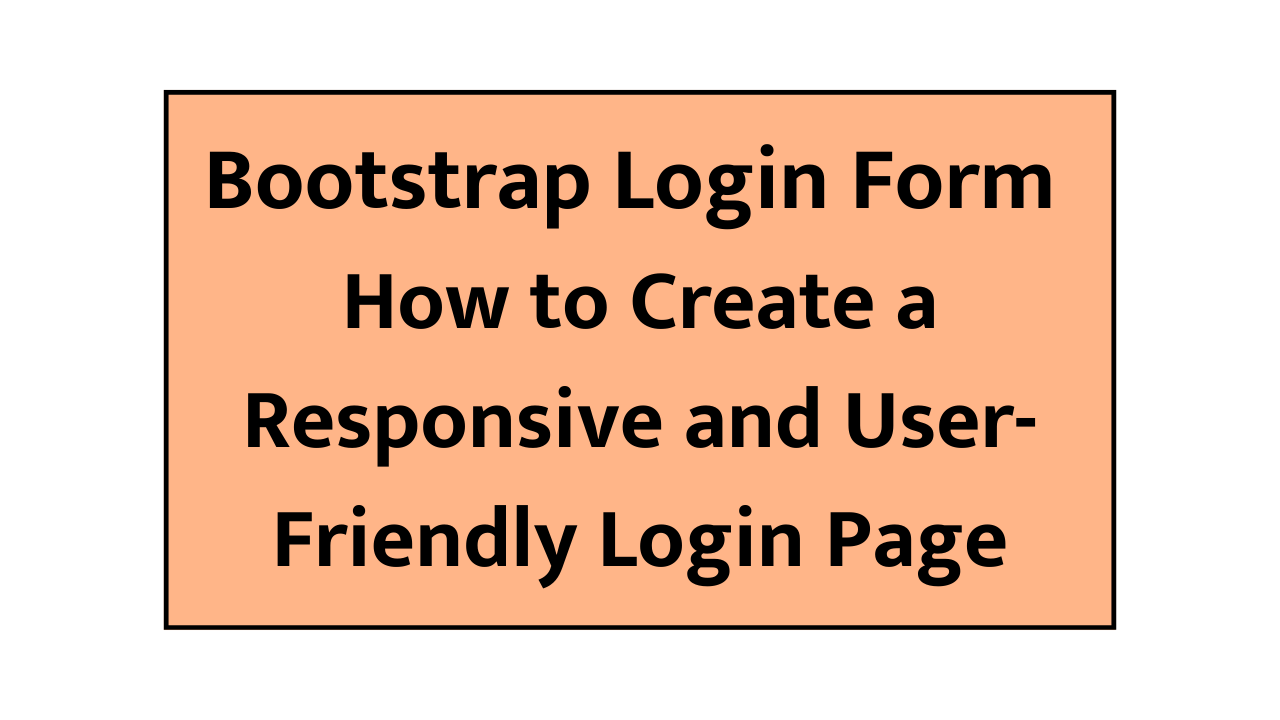Bootstrap Login Form : How to Create a Responsive and User-Friendly Login Page
A Bootstrap login form is an essential component of any website or web application. It helps users sign in securely and access personalized content. Bootstrap makes it easy to design a responsive, mobile-friendly, and stylish login form without writing too much CSS. In this article, we will discuss how to create a Bootstrap login form step by step, including best practices and SEO tips.
Why Use Bootstrap for a Login Form?
Bootstrap is a popular front-end framework that helps developers create responsive and visually appealing web pages quickly. Here are some reasons to use Bootstrap for login forms:
- Mobile-friendly: The login form adjusts automatically to different screen sizes.
- Pre-designed components: Bootstrap provides ready-to-use buttons, form controls, and grid systems.
- Customization options: You can modify the design with simple CSS or Bootstrap classes.
- Fast development: Saves time compared to writing custom CSS from scratch.
- Cross-browser compatibility: Works well on Chrome, Firefox, Edge, and Safari.
Features of a Good Login Form
A user-friendly login form should have:
- Username or email input field – Allows users to enter their credentials.
- Password field – Ensures security with hidden characters.
- Remember Me option – Lets users stay logged in.
- Forgot Password link – Helps users recover their accounts.
- Login button – Submits the form.
- Social login buttons (optional) – Enables login via Google, Facebook, etc.
- Error messages – Displays validation errors for incorrect inputs.
Step-by-Step Guide to Create a Bootstrap Login Form
1. Set Up Bootstrap
First, include Bootstrap in your HTML file. You can use CDN (Content Delivery Network) to add Bootstrap quickly.
<!DOCTYPE html>
<html lang="en">
<head>
<meta charset="UTF-8">
<meta name="viewport" content="width=device-width, initial-scale=1.0">
<title>Bootstrap Login Form</title>
<link href="https://cdn.jsdelivr.net/npm/bootstrap@5.3.0/dist/css/bootstrap.min.css" rel="stylesheet">
</head>
<body>
2. Create the Login Form
Now, add the Bootstrap login form inside a container.
<div class="container d-flex justify-content-center align-items-center min-vh-100">
<div class="card p-4 shadow-lg" style="width: 350px;">
<h3 class="text-center mb-3">Login</h3>
<form>
<div class="mb-3">
<label for="email" class="form-label">Email address</label>
<input type="email" class="form-control" id="email" placeholder="Enter your email" required>
</div>
<div class="mb-3">
<label for="password" class="form-label">Password</label>
<input type="password" class="form-control" id="password" placeholder="Enter your password" required>
</div>
<div class="mb-3 form-check">
<input type="checkbox" class="form-check-input" id="rememberMe">
<label class="form-check-label" for="rememberMe">Remember Me</label>
</div>
<button type="submit" class="btn btn-primary w-100">Login</button>
<div class="text-center mt-2">
<a href="#">Forgot Password?</a>
</div>
</form>
</div>
</div>
3. Add CSS for Styling (Optional)
You can improve the design with some custom CSS.
<style>
body {
background-color: #f8f9fa;
}
.card {
border-radius: 10px;
}
.btn-primary {
background-color: #007bff;
border: none;
}
.btn-primary:hover {
background-color: #0056b3;
}
</style>
4. Add JavaScript for Validation (Optional)
To enhance security, you can use JavaScript for basic validation.
<script>
document.querySelector("form").addEventListener("submit", function(event) {
let email = document.getElementById("email").value;
let password = document.getElementById("password").value;
if (email === "" || password === "") {
alert("Please fill in all fields.");
event.preventDefault();
}
});
</script>
</body>
</html>
SEO Optimization Tips for a Login Page
1. Use Proper Meta Tags
Include relevant meta descriptions and keywords.
<meta name="description" content="Create a responsive Bootstrap login form with email, password, and validation options. Learn how to design a secure login page.">
2. Optimize for Speed
- Use CDN for Bootstrap.
- Minify CSS and JavaScript files.
- Optimize images.
3. Mobile Responsiveness
Ensure the form works well on all screen sizes.
4. Use Alt Text for Images
If you include a logo or icons, add alt text for SEO.
<img src="logo.png" alt="Website Logo">
5. Secure the Login Form
- Use HTTPS for encryption.
- Implement CAPTCHA to prevent bots.
- Enable password hashing on the backend.
A Bootstrap login form is a crucial part of any website. Using Bootstrap, you can create a responsive, stylish, and user-friendly login page in minutes. Follow the best practices mentioned in this guide to improve security, SEO, and user experience.
If you are developing a professional website, always ensure your login form is secure, optimized, and accessible for all users.
READ ALSO : How to Become a PHP Developer : A Complete Guide


![Top Python Interview Topics: A Beginner’s Guide for Students [Latest 2025]](https://developer.thrend.in/wp-content/uploads/2025/11/ChatGPT-Image-Nov-18-2025-02_21_01-PM.png)
